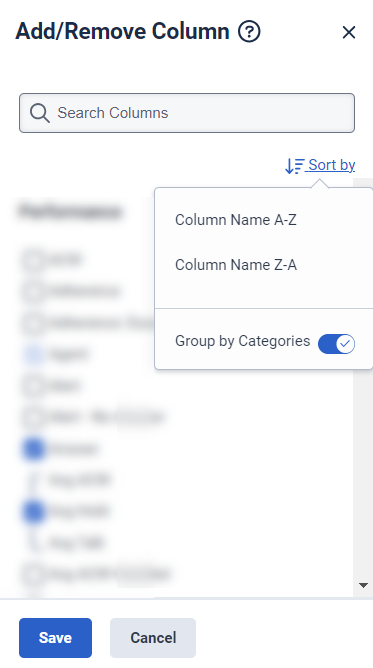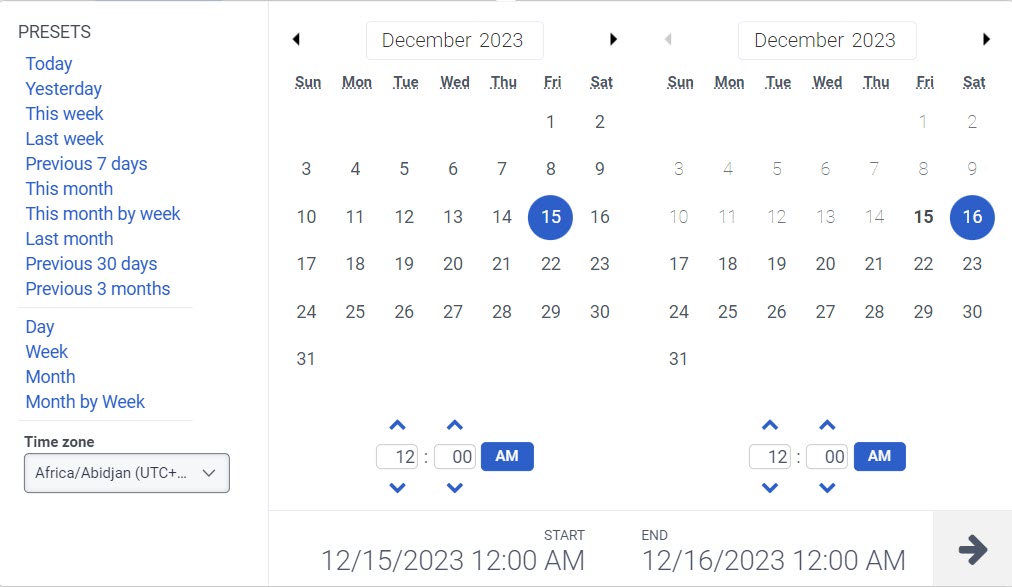DNIS Performance Detail view
The following permissions:
- Analytics > Conversation Aggregate > View
- Analytics > Data Export > All
- Routing > Queue > View
- UI > Supervisor DNIS Performance > View
- UI > Supervisor Queue Details > View
The DNIS Performance Detail view displays statistics based on a specific DNIS a customer dials to reach your contact center. These statistics can help supervisors determine performance issues with a specific DNIS in one or multiple queues.
Available columns
To view the available columns, see DNIS Performance Detail view section in the View available columns in performance views by category article.
To view the consolidated list of available columns in the performance views, see Consolidated view of available columns in performance views.
To view the list of available columns in the performance views by category, see View available columns in performance views by category.
Set a default time zone in the workspace
You can set the default time zone in the analytics workspace before viewing any analytics view.
To set the default time zone in the workspace, follow these steps:
- Click Performance > Workspace.
- On the left side, from the Time zone drop-down menu, select the required time zone as the default time zone for the analytics workspace.
View data for a DNIS
- Click Performance > Workspace > Contact Center > DNIS Performance.
- To see more details for a specific DNIS number, from the DNIS Performance Summary view, click a DNIS.
- To see the most current data, click Refresh . This view does not update automatically.
- To save the view with your filter and column settings, click Save .
- To export the data in the view, click Export .
- To view a summary graphic of a metric, at the top of the page, click that metric.
View aggregate data for multiple DNIS numbers
- Click Performance > Workspace > DNIS Performance.
- On the DNIS Performance Summary view, in the Filter by full DNIS field, search for and select multiple DNIS numbers.
- Near the list of DNIS numbers you selected, click View as group. Genesys Cloud displays the DNIS Performance Detail view with aggregate data for the DNIS numbers you selected.
- To see the most current data, click Refresh . This view does not update automatically.
- To save the view with your filter and column settings, click Save .
- To export the data in the view, click Export .
- To view a summary graphic of a metric, at the top of the page, click that metric.
Customize the view
Customize the DNIS Performance Detail view to show only certain data. For example, you can choose to show only certain columns or filter to see certain types of interactions. You can also save your filter and column settings as a saved view to quickly switch between different data of interest in the same view.
To customize analytics views, use the date filter.
To filter metrics by date or configure a custom date range, use presets. When filtering metrics for this view, select any custom date range up to 6 weeks.
To use a preset to filter metrics, complete the following steps:
- To display the date filter, click the date.
- In the Presets list, select a preset date option.
Date presets
| Presets | Description |
|---|---|
| Today | Shows data for the time period that includes the current interval. |
| Yesterday | Shows data for the previous day. |
| This week | Shows data for a Sunday through Saturday time period. |
| Last week | Shows data for the previous week, Sunday through Saturday. |
| Previous 7 days | Shows data for the previous seven days. |
| This month | Shows data for the current month, with no extra days. |
| This month by week | Shows data for the current calendar month starting on Sunday and ending on Saturday, including extra days if the month does not start on Sunday or end on Saturday. |
| Last month | Shows data for the previous calendar month with no extra days. |
| Previous 30 days | Shows data for the previous 30 days. |
| Previous 3 months | Shows data for the previous 3 months. For example, Nov 1, 2022 – Jan 31, 2023. |
| Day | Shows data for a single 24-hour day. |
| Week | Shows data for a Sunday through Saturday time period. |
| Month | Shows data for the exact month with no extra days. If the current month is selected, you can see the data up to the current date. |
| Month by Week | Shows data for a calendar month starting on Sunday and ending on Saturday, including extra days if the month does not start on Sunday or end on Saturday. |
To use a custom date range to filter metrics, complete the following steps:
- Click the date to display the date filter.
- Select a start date and an end date on the calendar, and click the filter arrow .
To view data for a different time period using the same date presets, click the arrows on either side of the date display. ![]()
For example, to view data for the previous day, click the Day preset, and then click the arrow on the left side of the date.
To view data for a different time zone using the same date presets, from the Time zone drop-down menu, select the required time zone. You can create and save reports with the same selected time zone.
Data in the view can be displayed in a chart. To view the chart, click the Show/Hide chart icon .
To show or hide columns:
- Click the Pick columns icon on the right side. The Add/Remove Column pane appears.
- (Optional) To sort the columns in ascending or alphabetical order, click Sort by > Column Name A-Z.
- (Optional) To sort the columns in descending or reverse alphabetical order, click Sort by > Column Name Z-A.
- (Optional) To categorize or uncategorize the columns, click Sort by and enable or disable the Group by Categories toggle. Click the image to enlarge.

- Search or scroll to select the columns you want to view. Note: You can also use keyboard navigation to choose the columns.
- Click Save. The selected columns appear on the screen. Note: The column selections appear only after saving the changes and do not apply to the table immediately.
To rearrange the columns, click a column header and drag it.
To reset a view to default column settings, click Reset view to defaults ![]() .
.
You can select up to 20 columns.
For more information about the metrics shown in the columns, see the Available Columns section in this article.
To filter by information about the interaction, click Filters , and then search or scroll to select the filter you want to use.
Interaction filters
| Filter | Description |
|---|---|
| Queue |
Displays metrics for interactions associated with the selected queues. Filter for multiple queues at one time by entering other queues and searching again. |
| Skills |
Displays metrics for interactions with agents who have the selected skills. Filter for multiple skills at one time by entering other skills and searching again. |
| Languages |
Displays metrics for interactions with agents who have the selected languages. Filter for multiple languages at one time by entering other languages and searching again. |
| User |
Displays metrics for interactions associated with the selected users. Filter for multiple users at one time by entering other users and searching again. To see and select inactive users in the User filter search, select Include inactive users. |
| Wrap-Up |
Displays information for interactions that have the selected wrap-up codes. Filter for multiple wrap-up codes at one time by entering other wrap-up codes and searching again. |
| Originating Direction | The initial direction of the interaction, such as inbound or outbound. |
| Provider | The source provider for the conversation. For example, Genesys Cloud EMAIL, Edge, and so on. |
| Routing Used | Displays the routing method that was used to get to the agent who answered the interaction. The routing data is relevant beginning September 5, 2020. |
| Routing Requested | Displays the routing methods that were requested for the interaction. Gives insight into each of the routing methods the conversation went through prior to being answered, abandoned, or flow-out. The routing data is relevant beginning September 5, 2020. |
| External Tag | Displays information for interactions that have the External Tag attached to the conversation record. Note: External tag data is not available for web chat interactions. |
To filter by information about the Predictive Engagement journey details of the interaction:
- Click Toggle filters panel .
- Click the Journey tab.
Journey filters
| Filter | Description |
|---|---|
| Has Customer Journey Data | Displays data for interactions that have customer journey data related to Predictive Engagement. |
| Proactive | Displays data for interactions where Predictive Engagement offered a chat during a customer's website visit based on the Predictive Engagement action map settings. |
To filter by information about External Contact details of the interaction:
- Click Toggle filters panel .
- Click the External Contact tab.
External Contact filters
| Filter | Description |
|---|---|
| External Contact | Displays information about interactions associated with the selected external contact. You can filter for:
When you filter by external contact, the contact name appears with the associated organization name. Filter for multiple external contacts at one time by entering another contact and searching again. Enable Include merged contacts to search all the contacts that relate to the external contacts in the filter. Note: You can associate each merged contact with many individual contact IDs. When you enable the Include merged contacts, all merged contact IDs are automatically added to the search. The search filters are limited to 200 total search dimensions.
For example, if you merge one contact into five other contacts, the search, performed along with the merged contacts, filters a total of six contacts. If an organization heavily uses the merged contacts, a search for a few external contacts can hit the search filter limit. |
| External Organization | Displays information about interactions associated with the selected external organization. You can filter for:
Filter for multiple external organizations at one time by entering another organization and searching again. |


